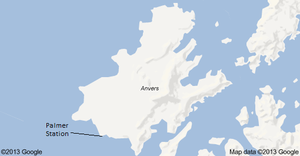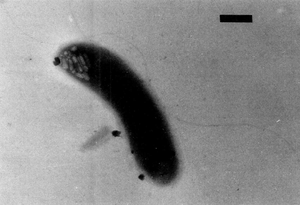Polaromonas vacuolata: Difference between revisions
From MicrobeWiki, the student-edited microbiology resource
No edit summary |
No edit summary |
||
| Line 9: | Line 9: | ||
===Cell Structure and Metabolism=== | ===Cell Structure and Metabolism=== | ||
[[File:Micrograph.png|300px|thumb|right|A micrograph of the organism, note the gas vacuoles at the top]] | [[File:Micrograph.png|300px|thumb|right|A micrograph of the organism, note the gas vacuoles at the top]] | ||
The bacteria which were studied were short, unicellular, gram-negative rods(0.8 by 2 to 3 pm) that typically produced gas vacuoles which appeared as bright refractile areas within the cells. [1] While the cells were non-motile when cultured, the appearance of flagella suggests that they are capable of | The bacteria which were studied were short, unicellular, gram-negative rods(0.8 by 2 to 3 pm) that typically produced gas vacuoles which appeared as bright refractile areas within the cells. [1] While the cells were non-motile when cultured, the appearance of flagella suggests that they are capable of self-propulsion. | ||
===Ecology=== | ===Ecology=== | ||
Revision as of 20:01, 12 April 2013
Higher Order Taxa
Bacteria; Proteobacteria; Betaproteobacteria; Burkholderiales; Comamonadaceae; Polaromonas
Description and Significance
Genome
Cell Structure and Metabolism
The bacteria which were studied were short, unicellular, gram-negative rods(0.8 by 2 to 3 pm) that typically produced gas vacuoles which appeared as bright refractile areas within the cells. [1] While the cells were non-motile when cultured, the appearance of flagella suggests that they are capable of self-propulsion.
Ecology
Related Bacterial Species
In 2004 another organism was proposed for the genus Polaromonas, Polaramonas Napthalenivorans CJ2, which is an aquatic gram-negative, non-spore formin, non-motile coccus. It is capable of growth with naphthalene as its sole carbon and energy source.[3]
Pathology
At this time, there are no diseases related to this organism have been observed.


